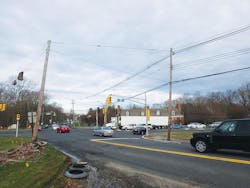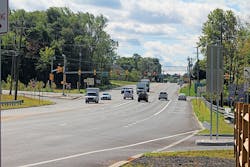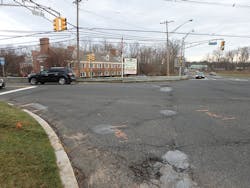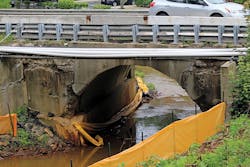The busiest intersection in Monmouth County, New Jersey gets a much-needed upgrade
This one was a long time coming.
It took years of tireless work by officials in Monmouth County, New Jersey—securing project funding, negotiating with various state entities, navigating complex permitting processes—but in 2017, work at last got underway to widen and rebuild the county’s busiest and most highly trafficked intersection.
The improvements in the heart of Colts Neck Township were sorely needed. More than 37,000 cars traveled daily through the intersection of State Route 34 and County Route 537. One of the longest county highways in the state, C.R. 537 has historic origins. It was once part of a King’s Highway, chartered in the late 17th century, that connected what were then the capitals of East and West Jersey. In modern times, travelers along the intersecting routes include many of the more than 10,000 students enrolled at a nearby community college, as well as motorists trying to access S.R. 18 to the south.
Monmouth County also contains numerous Jersey Shore communities, and the intersection was perpetually congested, with motorists on C.R. 537 in particular experiencing delays during peak periods. Traffic worsened during the fall season, when orchards offered apple and pumpkin picking. This in turn led to increased gridlock on nearby alternate routes, as drivers attempted to avoid the intersection. Two bridges approaching the intersection, which carried traffic over the winding waters of Mine Brook, were decades old and in need of replacement.
At the groundbreaking for the construction in October 2017, then-Senator Jennifer Beck described the project as “life-changing” for residents of the community and surrounding region. Then-Freeholder Director Lillian G. Burry, a former mayor of Colts Neck, added, “For years, business owners, residents, and travelers alike have suffered long wait times and hazardous driving conditions, and this will dramatically change how people travel in and around the heart of Colts Neck.”
Scope of work
T&M Associates was engaged in a construction management capacity to help plan and administer the $17+ million project, which was designed by Greenman-Pedersen Inc. and constructed by Rencor Inc. The challenges and considerations were numerous. Over a three-year period, and planned in several phases, the team would be making a wide variety of major improvements, including:
- Widening of S.R. 34 to accommodate exclusive left- and right-turn lanes, two through lanes, and new receiving lanes along both approaches to the intersection
- Widening of C.R. 537 to accommodate an exclusive left-turn lane, a through lane, a shared through/right lane, and two receiving lanes along both approaches
- The installation of New Jersey DOT traffic signals
- The replacement of two bridges with concrete culverts
- The installation of retaining walls, curbs, and ADA-compliant ramps and guide rails
It is unusual for a county to take the lead on a massive project that includes the intersection of both a county road and a state road. Throughout the project, current Director of the Board of County Commissioners Thomas Arnone and other community stakeholders emphasized the need to minimize disruption and keep traffic flowing throughout the project. This necessitated some temporary daily detours and restrictions of lanes during construction.
“We worked closely with local businesses, including large farms and country markets, a brewery and restaurant, and a shopping plaza, to minimize disruptions to their operations—at some points staggering the work on certain sections based on their business hours to keep their driveways open,” said Arnone. “Constant communication with the community—for example, as temporary lane closures or reroutes went into effect—was also a continuous priority.”
Of course, like any project of this size and complexity, it was not without the occasional challenge. For example, the construction necessitated the relocation of utility poles and overhead utility lines; major underground gas transmission mains, and fiber optic and telephone lines; and various utility service connections. As the utilities were relocated, temporary rerouting of drainage was necessary to keep water flows intact. And due to the height of overhead high-tension wires over the S.R. 34 bridge, it was necessary at one point in the project to change the design of the foundation for the culverts and retaining walls from what was originally proposed, switching from continuous flight augers to drilled shafts due to height restrictions. Fortunately, the change and approvals were met without any discrepancy in cost.
Because the project was partially funded by federal dollars, there were also certain key criteria involved, all of which were met by Rencor. These stipulations included a minimum Disadvantaged Business Enterprise (DBE) threshold, and a requirement to employ trainees performing approximately 2,500 hours of work across six separate job skills.
Another concern was environmental considerations, always an important factor both from a regulatory and ethical standpoint. In adherence with New Jersey Department of Environmental Protection guidelines and soil erosion, T&M oversaw numerous landscaping and drainage improvements, the construction of two bio-retention basins for storm-water management, and the planting of more than 400 trees at a nearby riparian mitigation site to minimize the project’s environmental impact. In addition, the former site of an adjacent gas station required the disposal of excess soil material. After testing, the Monmouth County Reclamation Center agreed to accept this for use in capping material, saving the county thousands of dollars in disposal fees.
The breakdown
For the asphalt construction itself, the roadways consisted of the following typical sections:
S.R. 34:
- Stone Matrix Asphalt: 2-in. 12.5 mm surface course
- Hot Mix Asphalt: 3-in. 19 M 64 intermediate course
- Hot Mix Asphalt: 6-in. 25 M 64 base course
- 5-in. dense graded aggregate base course
- 5-in. subbase
C.R. 537:
- Hot Mix Asphalt: 2-in. 9.5 M 64 surface course
- Hot Mix Asphalt: 6-in. 19 M 64 base course
- 5-in. dense graded aggregate base course
Asphalt Quantities:
- HMA Milling, 3 in. or Less – 22,645 sq yd (combined S.R. 34 and C.R. 537)
- Stone Matrix Asphalt 12.5 mm surface course – 2,980 tons (RT 34)
- Hot Mix Asphalt 9.5 M 64 surface course – 1,642 tons (C.R. 537)
- Hot Mix Asphalt 19 M 64 intermediate course – 3, 407 tons
- Hot Mix Asphalt 19 M 64 base course – 2,100 tons
- Hot Mix Asphalt 25 M 64 base course – 4,253 tons
The subgrade material was tested using the proctor compaction testing method, which involves classifying the existing material and defining the desired maximum density of the soil type and its optimum moisture content. Structural concrete testing was completed on all components of the site, including the two bridges, foundations, abutments, parapets, and traffic signal foundations, and random tests were performed on the new curbs and sidewalks. The appropriate testing was also conducted on the various levels of hot mix asphalt courses, including nuclear density gauge testing to ensure sufficient compaction and analysis of asphalt cores for thickness and air-void requirements after paving. Crews also observed post-tension testing of the new bridges to ensure that all project specifications were met.
A typical crew consisted of between six and 16 workers, typically on a five-day-a-week schedule over the course of nearly three years. Final milling, paving, and striping operations, with support from local police officers to manage traffic flows, occurred in May 2020. Although the team experienced a slight delay due to the onset of the COVID-19 pandemic, road and bridge construction was deemed essential pursuant to a statewide executive order. T&M worked closely with the various project stakeholders to ensure that Center for Disease Control guidelines for sanitization, social distancing by work crews when possible, and the wearing of masks were reinforced.
Closing it up
Final walk-throughs with the county and NJDOT officials took place on schedule (based on client-approved change orders) in September 2020. In January 2021, Monmouth County officials held a ribbon-cutting ceremony at the intersection to mark the completion of work and celebrate the combined roadways’ many improvements.
For the project team, it has been rewarding to see this project come to fruition. Again, it was a long time coming, which is why a bronze plaque erected at the site, recognizing then-Freeholder Director Lillian G. Burry and the other members of the Monmouth County Board of County Commissioners, is emblazoned with the words “A Persistence of Vision.” Traffic and congestion in the region have lessened considerably due to increased capacity at the traffic signal along the approaches from both S.R. 34 and C.R. 537, and commuters to school and work through the new intersection will continue to enjoy a quicker, safer, and less stressful ride even after pandemic-related restrictions have eased.






